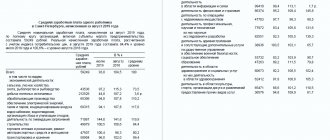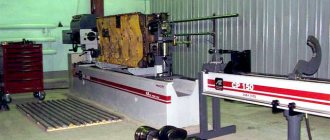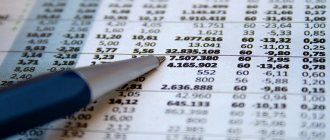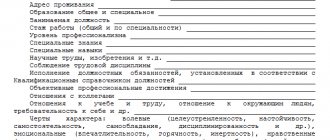What does this report consist of?
This report form undergoes changes every year, so before filling out and submitting, make sure this form is up to date.
Form No. 11 consists of a title page and four sections:
- I “Availability, movement and composition of fixed assets”;
- II “Availability of fixed assets”;
- III “Fixed assets that are not subject to depreciation”;
- IV “Information on territorially isolated units.”
The title page consists of:
- Name of organization
- His OKPO
- For what year is the organization provided and the address
Section 1:
This section consists of the table:
- adjustment of the full accounting value of the object as a result of revaluation as of the end of the reporting period or as a result of a decrease in the value of assets;
- increase or decrease in the total accounting value of the object;
- availability of the object at the end of the year at full accounting value, adjusted for revaluation, which was carried out at the end of the reporting period, as well as adjusted for impairment of assets;
- availability of the object at the end of the year at the residual book value, adjusted for revaluation, which was carried out at the end of the year, as well as adjusted for impairment of assets;
- accounting depreciation of fixed assets accrued during the reporting year;
- depreciation of fixed assets;
- accounting depreciation, which relates to liquidated fixed assets.
Important! These indicators are presented both in relation to all fixed assets available during the reporting year, and broken down into groups represented by real estate, machinery and equipment, inventory, plantings, working and productive livestock, and intellectual property.
Section 1 below the table also contains information: (click to expand)
- about the cost at which other assets are primarily accounted for (line 19);
- volume of investments in OS (line 20);
- average annual full accounting value of fixed assets (line 21);
- the prices of which year included fixed assets as of the end of the reporting year related to real estate, machinery and equipment, as well as vehicles (lines 22–26);
- the average age of the company's fixed assets related to real estate, machinery and equipment, as well as vehicles (lines 27–30);
- the actual construction period of real estate objects put into operation by the company in the reporting year (line 31);
- the cost of the actual sale of OS to third parties - except for sale for liquidation purposes (line 32).
Who submits Form 11 and when?
Form 11 (short) “Information on the availability and movement of fixed assets (funds) of non-profit organizations” is intended for all legal entities of any form of ownership and type of economic activity that belong to non-profit organizations (NPOs), as well as state and local government bodies.
For commercial organizations there is also a report on fixed assets - Form 11 without abbreviations, which includes information about fixed assets and other non-financial assets.
Non-profit organizations submit a report every year. The 2019 form must be submitted to the territorial body of Rosstat before April 1.
The place where the report is submitted varies depending on the conditions:
- If the organization has separate divisions, submit a report for each division from another constituent entity of the Russian Federation to the territorial body of Rosstat at their location and for a legal entity without divisions at the location of the head division.
- If the organization has fixed assets in two or more constituent entities of the Russian Federation, submit a separate form for each subject in a similar manner.
Form 11 (short) in 2020
By Order of Rosstat dated July 4, 2019 No. 382, a new form 11 (short) was approved, which is used starting with reporting for 2018.
Form 11 (short) valid in 2020
Innovations have significantly changed the order of filling out and the appearance of the form.
1. In section I, columns appeared:
- with a unit of measurement,
- changing the full accounting value by bringing the value of assets to fair and cadastral value,
- At what cost is other receipt of fixed assets primarily taken into account in column 5.
2. Information on the availability of fixed assets at the end of the year at full accounting and residual book value must be reflected taking into account changes by bringing the value of assets to fair and cadastral value.
3. Two new lines 14.1 and 14.2 have appeared. They detail other types of fixed assets and reflect information about capital investments in radical land improvements and the costs of transferring ownership of non-produced assets.
4. Information on the availability and movement of fixed assets by type of economic activity (lines 15–17) became section II.
5. In Section III, a place has been added to indicate the average age of fixed assets.
6. In Section IV, space has appeared for information on the full accounting value of separate divisions.
Section 2 (additional OS information)
The main element of this section is also the table. It shows:
- the volume of profitable investments in material assets (line 33);
- the cost of fixed assets that are taken into financial lease when recorded on the lessee’s balance sheet (line 34);
- the cost of fixed assets that are leased and are recorded on the lessor’s balance sheet (line 35).
Important! Here is the cost of fixed assets leased, with their accounting on the lessee's off-balance sheet account (line 36), and leased, with their accounting on the lessor's off-balance sheet account (line 37).
The table below shows:
- cost of fixed assets used for environmental protection purposes (line 38);
- the amount of accumulated capital investments used to improve land (line 39);
- the amount of accumulated expenses associated with the transfer of ownership of assets that are classified as non-produced (line 40);
- the cost of costs for work in progress equipment and vehicles intended for internal use (line 41);
- the cost of equipment to be installed in the company (line 42);
- the amount of costs related to the unfinished construction of real estate for internal use (line 43).
Below the table in section 2 the following data is also provided:
- on the amount of capital investments for land improvement (line 44);
- the amount of expenses for the transfer of ownership of assets classified as non-produced (line 45).
| ★ Best-selling book “Accounting from scratch” for dummies (understand how to do accounting in 72 hours) > 8,000 books purchased |
Instructions for filling out Form 11 (brief)
Instructions for filling out the form are given in Appendix No. 2 to Rosstat Order No. 449 dated July 19, 2018. More detailed provisions are given in Rosstat Order No. 717 dated November 29, 2019.
The form itself includes a title page and two sections.
Title page
The title page of the form is filled out as standard. Indicate the reporting year - 2020, full and short name of the organization, legal postal address or actual location address, if they do not match
In the code part of the form, indicate the OKPO code based on the notification of its assignment.
Section 1. “Availability, movement and composition of fixed assets”
In line 01, reflect all fixed assets that you have under the right of ownership, management, operational management or lease, recorded in the fixed asset accounts. This also includes intellectual property.
This line does not take into account unfinished assets and objects that are not classified as fixed assets according to the following criteria:
- cost up to 10 thousand rubles per unit on off-balance sheet account 21;
- 100% depreciation when putting the facility into operation;
- costing up to 40 thousand rubles per unit, and for those put into operation from January 1, 2020 up to 100 thousand rubles - for organizations of state authorities and local self-government, management bodies of extra-budgetary funds, state academies, institutions, as well as budgetary, state-owned and autonomous institutions ;
- costing no more than 20 thousand rubles per unit, and for those put into operation from January 1, 2011 no more than 40 thousand rubles - for other non-profit organizations.
But if these assets are reflected in accounting as part of fixed assets, then they are reflected in the form until they are written off or disposed of for other reasons.
Keep records of exports and imports in the Kontur.Accounting web service. Simple accounting, payroll and reporting in one service
Next, all fixed assets are distributed by type according to the classifier of fixed assets (OKOF).
| Line number | Fixed assets | Note |
| 02 | residential and non-residential buildings | free-standing buildings, external extensions and outbuildings (wells, fences, sheds) |
| 03 | residential buildings | general purpose housing stock, buildings, dormitories, dormitories, departmental housing on the balance sheet, data on the non-residential part of buildings is excluded |
| 04 | structures | highways, streets, landing strips, highways and railways, bridges, dams, pipelines, flower beds, fountains, parking lots, etc. |
| 05 | machinery, equipment and vehicles | |
| 06 | vehicles | transport rolling stock |
| 07 | information, computer and telecommunications equipment | information equipment, complete machines, electronic control devices for equipment and its components, computers |
| 08 | other machinery and equipment, including household equipment and other objects | items not used in production or used but not classified as equipment or structures - playgrounds, furniture, benches, etc. |
| 09 | cultivated biological resources that repeatedly produce products | animals, trees, vineyards, orchards, plantations |
| 10 | cultivated biological resources of animal origin | breeding cattle, dairy herds, draft animals, animals for wool production, animals for transportation, racing and entertainment, animals for slaughter and animals under productive age are excluded |
| 11 | working and productive livestock from line 10 | working animals, food animals |
| 12 | cultivated biological resources of plant origin | cultivated perennial plantings, regardless of age, (except those grown as planting material) |
| 13 broken down into five subparagraphs | objects related to intellectual property and products of intellectual activity | results of intellectual activity on a low-value material medium:
|
| 14 | other types of fixed assets | library collections, copies of works of art, films and photographs, circus and zoo animals, watchdogs, etc. |
In addition to the lines, the table of the reporting form includes 11 columns, according to which information about fixed assets must be indicated:
- column 3—change in full accounting value by bringing the value of assets to fair and cadastral value
- columns 4–5 - increase in total accounting value for the year;
- columns 6–8 - decrease in the total accounting value for the year;
- Column 9 - availability at the end of the year at full accounting value, taking into account changes due to bringing the value of assets to fair and cadastral value;
- Column 10 - availability at the end of the year at the residual book value, taking into account changes due to bringing the value of assets to fair and cadastral value;
- column 11 - accounting depreciation of fixed assets accrued for the reporting year;
- column 12 - accounting depreciation for liquidated funds;
- Column 13 - at what cost is primarily included in gr. 5 other receipt of fixed assets.
In column 3, it is necessary to take into account cases in which the organization revalued to fair value or applied the procedure for impairment of fixed assets. Revaluation of fixed assets of public sector organizations is carried out in the following cases:
- revaluation of fixed assets intended for disposal not in favor of public sector organizations to fair value;
- revaluation of real estate state (municipal) property to cadastral value;
- revaluation of fixed assets constituting treasury property.
In column 4, indicate the cost of fixed assets obtained through the commissioning of new facilities during their purchase, manufacture, receipt from the founders or as a gift, as well as the completion, reconstruction or modernization of existing facilities, receipt of fixed assets by import.
In column 5, indicate data on the increase in value due to the acquisition of funds on the secondary market, the contribution by the founder of used funds to the authorized capital, as well as proceeds during reorganization.
Column 6 reflects the write-off of fixed assets, meaning the physical liquidation of the relevant objects, as well as their sale for the purpose of physical liquidation. Funds that are 100% depreciated but continue to be used are not counted.
In column 7, from the liquidated funds, highlight those that were liquidated due to natural and man-made disasters.
In column 8, reflect the decrease in value due to the disposal of funds due to sale or transfer to another organization, stolen or missing funds and funds transferred during reorganization.
The sum of the data in columns 6 and 8 is the total amount of reduction in the full accounting value of fixed assets for the reporting year.
In columns 9 and 10, indicate the availability of fixed assets at the end of the year at different values - at full accounting and residual balance sheet, respectively. The difference between the values is equal to the depreciation of these funds over all years of operation (column 10).
In column 11, reflect the accounting depreciation accrued on fixed assets for the reporting year during the periods when these funds belonged to the reporting organization, and not accumulated by the end of the reporting year for the entire period of operation of the fixed assets object.
In column 12, reflect the accounting depreciation of fixed assets liquidated during the year, accumulated over the entire period of operation. The amount of accounting depreciation of liquidated fixed assets should in most cases be 75–100% of their full accounting value.
In column 13 you need to select the preferred type of cost:
1 - current value; 2 - the full accounting value that existed with the previous owner (with the transfer of accumulated depreciation); 3 - residual book value that existed with the previous owner.
Control ratios for checking the correct completion of Form 11 are given at the end of the instructions for completion. At the end of the first section, provide background information by entering the numbers in the appropriate lines.
Section 2 “Availability and movement of fixed assets by type of economic activity”
A non-profit organization may conduct one or more activities that are consistent with its operational goals.
Fixed assets of structural divisions are distributed among the main and secondary types of activities, not object by object, but by structural divisions based on the primary nature of the actual activities of each. Therefore, the fixed assets of each structural unit must be entirely assigned to one of the types of activities of OKVED2 of the highest level of the hierarchy (one-letter codes).
On lines 16–17, distribute the fixed assets of structural divisions by type of economic activity in accordance with OKVED2 - letter only. If several divisions belong to the same type of activity, then they are recorded in one line. Line 16 takes into account the fixed assets of structural units related to the main type of activity: for non-profit organizations this is the one with more employees, and for government bodies, budgetary and public organizations - the one that is defined in the statutory documents.
Section 3. “Availability and average age of fixed assets”
Line 18 of the fixed assets recorded in line 01, column 9 reflects the full accounting value of fixed assets for environmental protection.
On line 19, reflect unfinished construction projects that continue to be built or work on them has been suspended, mothballed, or finally terminated. But the object has not been written off. The same line takes into account equipment that requires installation and is intended for installation, as well as fixed assets reflected in accounting (and budget) accounting in the “Non-financial assets in transit” accounts, for which a future owner has already been found who will use them.
In line 20, indicate the average annual full accounting value of all fixed assets accounted for on line 01. The average annual full accounting value is determined as the quotient of dividing by 12 the amount obtained by adding half of the total accounting value of all fixed assets of the organization at the beginning and end of the reporting year and the cost of fixed assets funds on the first day of each of all other months of the reporting year.
In lines 21 - 24, provide the results of estimating the average age of fixed assets, that is, the number of years (rounded to the nearest whole number) that have passed from the date of manufacture to the end of the year. Divide them accordingly by buildings, structures, machinery and equipment, and vehicles.
Section 4. “Average annual total accounting value of the organization’s fixed assets”
There is only one line in this section - 25. For it, show information about the average annual full accounting value of fixed assets separately for the head division and for separate divisions in the same entity. If these divisions do not have fixed assets, then they are also taken into account, and “0” is entered in column 3 on line 25.
If the number of separate units, together with the head division, that have fixed assets in the subject is more than one, then include in the report additional sheets with the fourth section.
Σ lines 25 for territorially separate divisions and the head division = line 20.
Fill out statistical reporting quickly and easily in the Kontur.Accounting service. Generate reports and send them to Rosstat online. All newcomers will receive a free period of two weeks.
Section 3 (FA without depreciation)
| Chapter | Explanation |
| Third section | Here the total cost of all fixed assets is recorded (line 46), for which depreciation is not accrued, with its division into related (lines 47–52):
Under the table in Section 3, the cost of young animals, birds, and fish, which are bred for repeated use, is also indicated (lines 53, 54). |
What OS is included in the form?
There is a division of fixed assets into groups. Not all subtypes of OS are included in form number 11 (abbreviated). According to official documents, only funds put into operation before January 1, 2011, the amount of which ranges from 20 to 40 thousand rubles (inclusive), should be reflected. The amount of actual depreciation does not matter: it can either reach 100% or be lower than this figure. The method of calculating depreciation should be linear.
The following fixed assets do not need to be entered in the form columns:
- funds in the amount of up to 40 thousand rubles, the operation of which has not been started;
- funds in the category from 20 to 40 thousand rubles, the use of which began on January 1, 2011 with 100% accrual;
- funds up to 20 thousand rubles.
All budget sources (funds and others) must be strictly checked by an accountant for compliance with current requirements for filling out the form.
Section 4 (OS by territorial divisions)
| Chapter | What does he talk about? |
| Section 4 | data is reflected on fixed assets at the disposal of separate divisions of the reporting company, which are located in the same subject of the Russian Federation with the head office. Here you need to indicate:
As many copies of Section 4 sheets are filled out as there are divisions of the reporting company, including those that do not have OS. |
Changes in Form 11 for 2020 and ways to obtain a blank form
Every year, form number 11 changes: mandatory and additional clauses on fixed assets are updated, and the design of the document changes. Current updates were made to the form on June 26, 2018. The full official instructions for filling out on November 30 were approved by order number 799 from Rosstat ().
The innovations affected some points and paragraphs. Thus, sample points number 5, 7, 11, 29 and some others have changed. Using the old filling instructions is no longer relevant.
The sample can be downloaded for free here and printed to fill out, or downloaded electronically. To avoid mistakes, it is better to take an example of the correct execution of a report on fixed assets.
Errors in the statistical report, liability for failure to report
1.The most common mistake in filling out this form may be the OKPO of the enterprise; to make it correct, refer to the certificate - notification from statistics, where these codes are indicated
2. Errors in determining fixed assets and indicators for them
Administrative liability is provided for violation of deadlines for submitting reports to statistical authorities. And for repeated violation you face a double fine. So let’s look at what preventive measures exist:
In case of a primary violation, a fine of from 20 to 70 thousand rubles is imposed on the organization, from 10 to 20 thousand on the responsible person; in case of a second violation, the fine will be up to 150 thousand for the organization, and up to 50 thousand for the responsible person.
Statistics make it possible to:
– collect and group data for all organizations with a common type of activity;
– determine the main indicators in the work to identify statistics;
– analyze data, display averages
Statistics are especially useful in economic activity. To create your own business, while future income and expenses are still unknown, statistical information comes to the rescue, allowing you to make further calculations and forecasts.
What fixed assets are reflected in Form No. 11
For the purpose of filling out Form 11, fixed assets include the following assets reflected in the balance sheet:
- from the group of articles “Fixed assets”: article “Buildings, machinery, equipment and other fixed assets”, article “Unfinished construction”, in terms of objects intended for own use or paid for by the customer;
- profitable investments in material assets;
- tangible prospecting assets;
- from the group of articles “Intangible assets”: assets related to intellectual property, objects of intellectual activity, the use of which is limited by legal or other protection;
- research and development results;
- intangible exploration assets (except for those related to non-produced assets in statistics).
Fixed assets also include assets to which the organization does not have exclusive rights, which are recorded on the balance sheet in the account “Intangible assets received for use” (in the full amount of expenses for the creation, acquisition of these objects, installation of software, etc.) , are reflected in account 97 “Deferred expenses” and the cost of which is written off as expenses during the entire period of use.
Form No. 11 does not include land plots and environmental management facilities, as well as intangible non-produced assets (for example, trademarks and business reputation).
Fixed assets are reflected in Form No. 11 at their original (replacement) and residual value.
A detailed procedure for filling out each section of the form, as well as control ratios that will allow you to check the correctness of filling out this statistical reporting, can be found in Rosstat Order No. 563 dated November 24, 2015.
Articles on the topic
In connection with the introduction of the federal accounting standard “Fixed Assets” for the public sector of the economy, Rosstat made changes to the statistical reporting form 11 short, mandatory for all non-profit organizations.
We talk about the adjustments made in Form 11 Brief. Read how to fill out the reporting table and distribute fixed assets by type of activity. Download the blank form of the new form 11 short in 2018-2019.
Briefly about batch accounting in enterprises
The algorithm for paperwork depends on which warehouse accounting method is chosen by the company. The batch of goods are:
- homogeneous products arriving for storage under one transport document;
- goods brought by one type of transport, the number of accompanying transport documents does not matter;
- belonging to the same inventory item, which entered warehouse storage with several transport papers from one supplier partner, and no differences in indicators were found.
Algorithm for working with inventory items and documentation for batch accounting:
- In the log of received goods and materials, the storekeeper enters data about each batch of goods that arrived at the warehouse, assigns a number to it (coincides with the item number in the log);
- for each batch, a batch card is created in the form MX-10 (2 copies), information about the arrival and release of goods is entered into it;
- MX-10 is closed when the entire batch is released from the warehouse, and a report is filled out in form MX-11 (when there are discrepancies in the receipt and expenditure of inventory indicators from one batch).
Important! The financially responsible person (hereinafter referred to as the MOL) fills out the documents. Usually this is the storekeeper.









